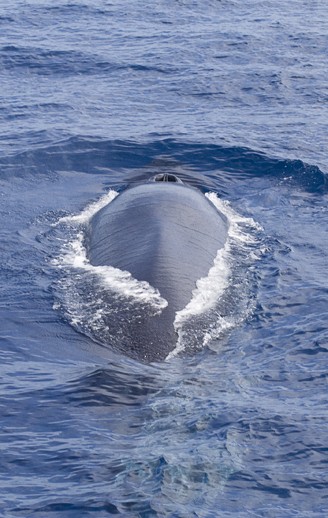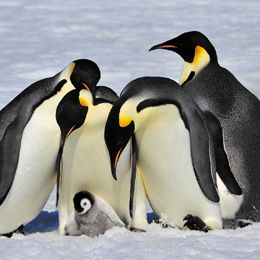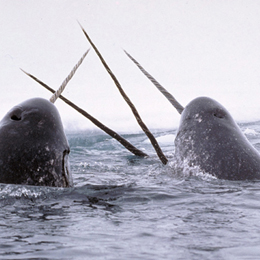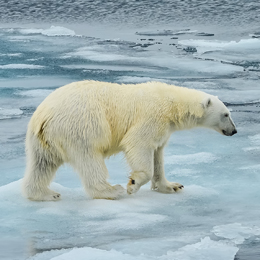Let’s Talk Whale
Finback whales are one of Nature’s most beautiful wonders that can be found swimming across the Pacific and Antarctic waters. Primarily they are solitary travelers, migrating from the North American coast to the Arctic Circle and mostly inhabit several parts of the temperate oceans.
Geographically cosmopolitan, Finback whales attain a length of 20 meters in the southern hemisphere whereas, in the Northern part of the sea, the mammal reaches an approximate size of 24 meters. This whale species is nocturnal, diurnal and nomadic showcasing a gentle and passive nature in the oceans.
Physical Description
Finback whales have been nicknamed ‘razorback’ because of their streamlined body that ends with a distinct ridge along the back end of the dorsal fin, which is about 60 cm high. Their long and sleek bodies, flattened V-shaped head and dorsal fins that run two thirds of the way down, gives a unique appearance. Weighing around 70,000 - 80,000 kg, both male and female finbacks live for about 85-90 years.
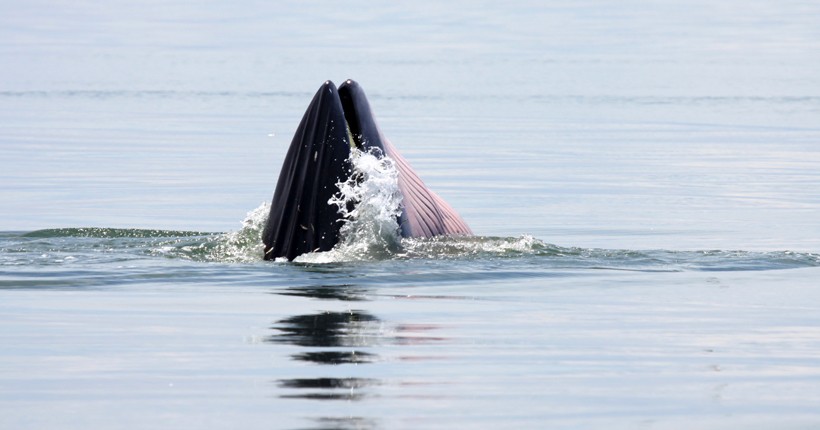
The dark grey-brown tone and 'white' underbelly is characteristic of the Finbacks
?
Image credits: KAMONRAT/Shutterstock
Communication
Found in almost all oceans of the world, Finbacks prefer temperate waters over the tropics. Seasonal migration of the Finback whale is slightly complex since both subspecies (North & South) follow their distinctive path. However, these mammals swim away from the coastlines and travel in packs of 6-7 to ward off predators.
Like blue whales, Finbacks also communicate through vocalizations (Echoes) producing a low-frequency sound that ranges between 16-40 Hz.
They are known for producing single and patterned pulses (20 Hz), low-frequency rumbles and non-vocal sounds that generate a sharp impulse within the sea.
High-frequency sounds are used to communicate within a pod which might contain information regarding availability or location of food. The 20 Hz pulses help Finbacks communicate on a distant level with pack members while the patterned waves are meant for courting during the breeding season.
Sub Species – Northern & Southern Finbacks
- physalus physalus in North Atlantic
- physalus quoyi in South Atlantic
The two subspecies of Finbacks rarely meet however there has been a study in 2013 that a third subspecies might exist in the North Pacific waters. All three subspecies show similar behavioral patterns and social interactions within their distinct pods.
On a physical note, adult females in the Southern Hemisphere reach about 85 feet in length while the males generally grow till about 82 feet. Finbacks in Northern Hemisphere show distinct body dimensions where the females reach a length of 74 feet and male finback whales maintain an average length of 69-70 feet.
Basic Anatomy
The slender build accompanied by a dark grey-brown tone and a white underbelly is characteristic of the Finbacks. Instead of teeth, Finback whales possess baleen plates made of keratin, in a set of 350-400 depending upon the age. They also have a series of 85-100 ventral grooves on the underside of the lower jaw. Sensory organs in rorquals are limited to reduce drag, for example, whales don’t possess external ears. They have a keen sense of hearing that depends upon an internal system of air sinuses and bones to detect sounds.
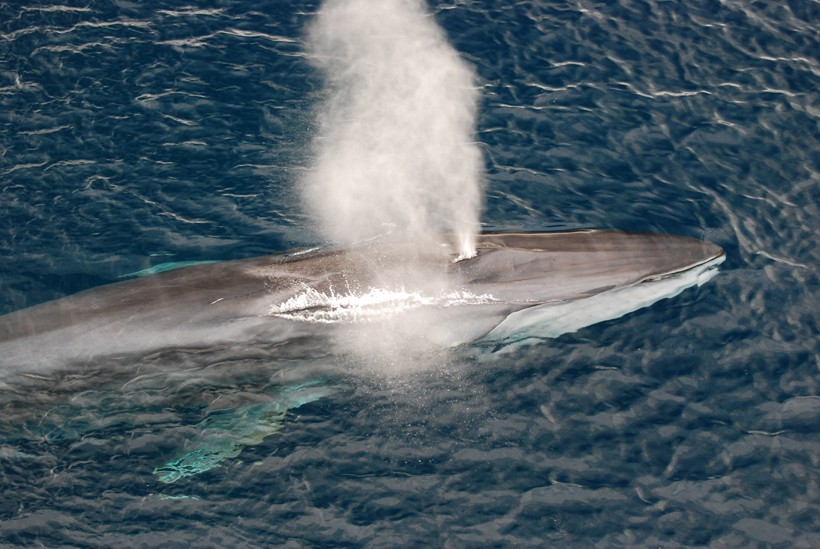
The whale blows around 5-8 times before swimming underwater again.
?
Image credits: Juan Gracia/Shutterstock
It is easy to distinguish Finback whales from other whales due to the presence of a medium sized white patch present on the lower region of the right jaw. Finback whales have small flippers; dominant and curved dorsal fin for agility with a wide fluke that is pointed at the tips.
The fin whale has an asymmetrical head with a dark colored bottom lip on the left while the right is pale white. Finbacks are gulpers that occasionally take in large mounds of concentrated food that is pushed into the gullet with the tongue.
Ecology and Habitat
Long and slender, conquering the mighty waves of the Atlantic and Pacific, Finback whales are the second largest rorquals and the second longest mammals after the Blue Whale. They particularly swim within shelf waters not deeper than 200 meters.
While some populations are migratory that move towards colder waters during the summer months, few others are sedentary. During the fall, they return to the warm temperate oceans. It is because of the difference in ocean currents and the climate of the Northern and Southern Hemisphere, research concludes that both subspecies rarely meet. Non-migratory populations run along the Mediterranean stretch and the Gulf of California.
- Geographical range from the North Pacific Ocean: Finbacks travel from the Chukchi Sea, Gulf of Alaska and around coastal California during the summers. In the winters, Finbacks migrate from the Sea of Japan, East China, and the Yellow Sea and into the Philippines.
- Geographical range from North Atlantic Ocean: Finbacks travel from the North American coast, past Greenland through the Arctic waters and cross Iceland, Norway to finally enter the Barents Sea. In the winter, such populations move towards the Caribbean through the Gulf of Mexico.
- Southern Hemisphere Finbacks migrate back and forth from Antarctica throughout the year.
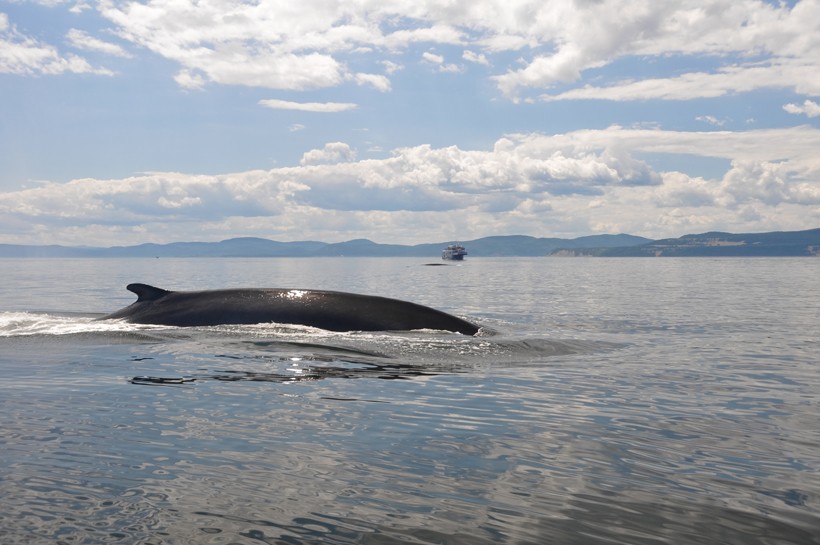
Finback Whale swimming in the st. Lawrence river, quebec (Canada)
?
Image credits: Alberto Loyo/Shutterstock
Diet
Finback whales have an ever changing diet depending upon the season and the region. During the winter months, feeding is generally low.
Their diet primarily consists of small crustaceans like Krill. However, they do hunt schooling species like Herring, Capelin, Cod etc. They are known as ‘filter feeders’ because they passively consume food by filtering prey out of the water.
According to recent scientific study, whales are said to possess a ganglion of grapefruit sized vessels located within the chins that allow these massive creatures to lunge forward during a feed. Such a well-placed organ gives whales an anatomical advantage with enhanced coordination for successful lunging.
This particular species also showcases asymmetrical pigmentation, a rare characteristic which explains its unusual coloring that plays a fundamental role in accumulating denser schools of fish.
It has been found that Finback whales circle schools of fish from the white side of the jaw that frightens the prey and condenses the school. This makes it easier for a Finback whale to catch prey and strain the concentrated food through its baleen plates.
The Hunted
Adult fin whales don’t have many natural predators. However there have been several cases where a finback that has strayed away from its pack, has been attacked by killer whales. Orca or killer whales are known for hunting whales hence the name. Orcas have built a reputation for hunting baleen whales and it is certainly one of nature’s greatest confrontations.
Orcas usually hunt in packs and tend to target juveniles i.e. specifically calves who cannot defend themselves against a pack’s attack. Humans also are responsible for killing a large number of finback whales (10,000 whales per year during the 1950s). According to a survey in 1979, nearly 750,000 finback whales have been hunted and killed in the Southern Hemisphere, due to which they are rarely seen today.
Reproductive Cycle
Seasonal breeding is observed in finback whales that are often seen in pairs and are known to be monogamous. Males use a patterned, repetitive low-frequency vocalization to court females during the breeding season.
Mating occurs in warm waters however no specific breeding grounds have been observed. The gestation period is about 11 to 11.5 months after which the mother undergoes a resting period of 5-6 months.
Each female gives birth to a single calf within a span of 2 to 3 years. There have been reports of finback females giving birth to a larger litter, however on an average, just a single calf survives. The mother nurses the infant for around 6-7 months and since young calves don’t have a natural ability to suckle, the mother sprays milk into the baby’s mouth. This takes place by contracting the circular muscles present at the base of the nipple sinus in female finbacks. Feeding generally lasts 8 to 10 minutes throughout the day.
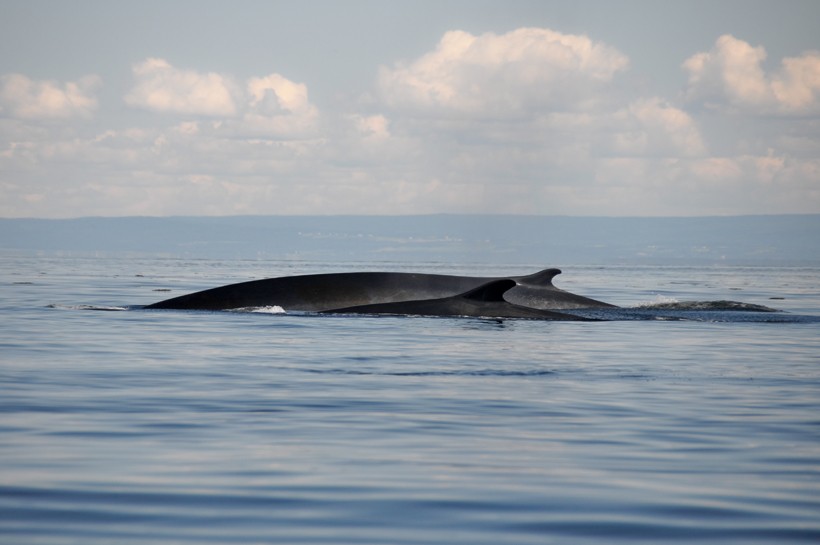
Finback whale swimming with newborn Calf (6 meter!)
?
Image credits: Alberto Loyo/Shutterstock
Newborns measure about 6 meters in length, having an approximate weight of about 3500-3600 kilograms (4000 pounds).
After gaining a size of 12 meters and above, young fin whales travel alongside their mothers to high-latitude feeding areas. The age of sexual maturity ranges to about 4 to 8 years in finback whales depending upon sex.
A male finback whale sexually matures after gaining a body length of about 18.6 meters. Females reach their sexual peak after gaining a body length of about 19.9 meters. Physical maturity takes place after 22 to 23 years.
Rorqual Hybrids
Interestingly it is quite common to come across hybrid species of Baleen whales. Hybridization between finback whales and blue whales is known to be a common occurrence once in 4-5 years. According to an Icelandic whaling expedition in 1986 discovered a whale that on close examination displayed morphological characteristics of both fin and blue whale. Pigmentation pattern at the flank and belly showed remote signs of hybridization.
Population Density
The present status of the whaling population of Finbacks is uncertain however they have mostly been spotted in the North Pacific and Atlantic Ocean.
According to a line transect survey in Hawaii, an estimate of 174 finback whales has been recorded in a 2004 report. The California/Oregon stock (basically the Pacific waters of the United States) was estimated to being 3279 based upon a winter analysis. A rough estimate of the population density of finbacks west of Kenai Peninsula has been recorded to being 5700 according to a 2007 report. According to the most current reports, the population of finback whales in the North Atlantic exceeds 46,000.
Behavior
Found mostly offshore, Finback whales swim across high latitudes and generally restrain from swimming in the equatorial region. Their nomadic nature carries them to an oceanic depth of around 1540 feet (470 meters), although most packs are generally limited to a range depth of 200-250 meters. Their dive sequence recorded is 5-8 blows approximately 60-70 seconds apart before they swim underwater again.
They are highly migratory; during the spring and summer, they prefer residing in cold waters while during the fall they move towards the warmer waters hunting for a mate.
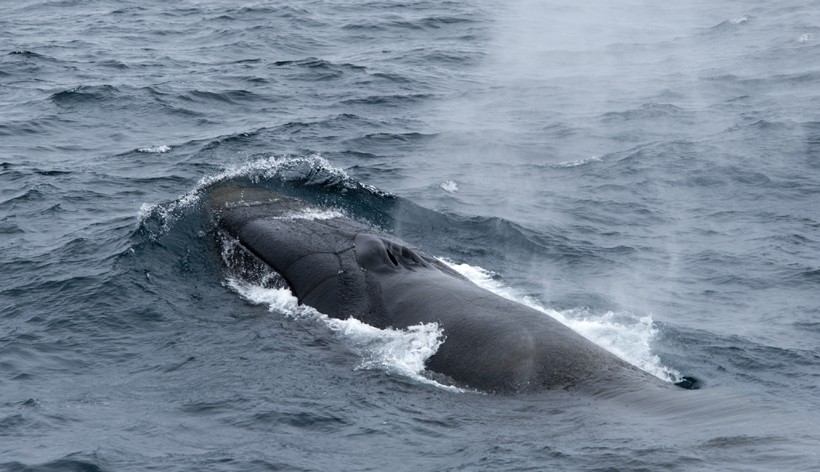
Finback whale prepares for the 50 minutes dive, Antarctica
?
Image credits: Petra Christen/Shutterstock
They are sociable species that generally travel in groups of 6-10 however feeding groups include about 250 individuals. Finback whales use ‘counter calling’ to communicate in the water to gain information about their surroundings.
Counter calling consists of sound frequencies expelled from one pod and answered by another pod. The acoustic echo that reflects back gives precise information to a pod regarding surrounding, threats and feed. General contribution of finback whales like other baleen whales is the same.
Threats
According to the IUCN Red List, finback whales are endangered owing to extreme overfishing and trawling. The invention of whaling technology depleted whale populations. In 2006 illegal whaling in Iceland resulted in 125-150 fin whales being harvested for their meat, skin, fin and oil. Entanglement and trawling as a result of unsupervised fishing gear killed 4 finback males and injured a mother and calf in the year 2000 to 2004.
In addition a lot of finback whales also get injured or are killed during vessel collisions. In 2004 & 2005, 5 vessel collisions were recorded that killed a large number of finback whales in the eastern coast of United States. In 2010, a dead fin whale was believed to have been a victim of a ship strike in the British Isles. Oil spills are another threat for most aquatic species leading to bio-magnification.
Use of military sonar and seismic surveys often disrupts mating between finback whales. This results in males not being able to mate reducing their birth cycles annually.
Since whales use low frequency sound waves, artificially produced sound waves by human intelligence interferes with the communication that takes place between pods of finback whales. This is also the reason why few finbacks stray from their pods and usually become a target for whalers or prey to a pack of orcas.
Note: After the conception of International Whaling Commission by the WWF, a zero limit was set for finback whale catchers all over the world particularly in the North Pacific and southern hemisphere. The IWC has set specific quotas for western Greenland and British Isles-Spain-Portugal to control overfishing.
Conservation Status
- IUCN (International Union for Conservation of Nature) - Endangered
- ESA (Endangered Species Act, 1973) - Endangered
- CITES (Convention on International Trade in Endangered Species of Wild Fauna and Flora) - Appendix 1 Endangered
- MMPA (Marine Mammal Protection Act, 1972) - Depleted
Funfacts
- Finback whales consume large amounts of plankton as part of the aquatic food web.
- Finback whales also host certain parasitic communities like barnacles, worms, lice etc showcasing a form of commensalism.
- Finback whales are a unique species that are found in both warm and cold marine habitats.
- Finback whales are very conservative by behavior and picky in terms of the kind of food they consume.
- They can make one of the deepest dives and can stay submerged for about 50 minutes.
- They can weigh up to 80 tons (2000 pounds)
- Finback whales are often confused with Minke whales; however their tales are shorter in comparison.
- Known as the greyhounds of the sea for their fast speed, finback whales can swim up to 30 mph (short bursts) but when alarmed or escaping from a predator they can swim up to 18 mph.
- Finback whales consume 2.8 tons of food each day during the summer months.
- Finbacks are said to have evolved from terrestrial hoofed mammals and through adaptive radiation (Darwinian Theory) about 40-45 million years ago.
